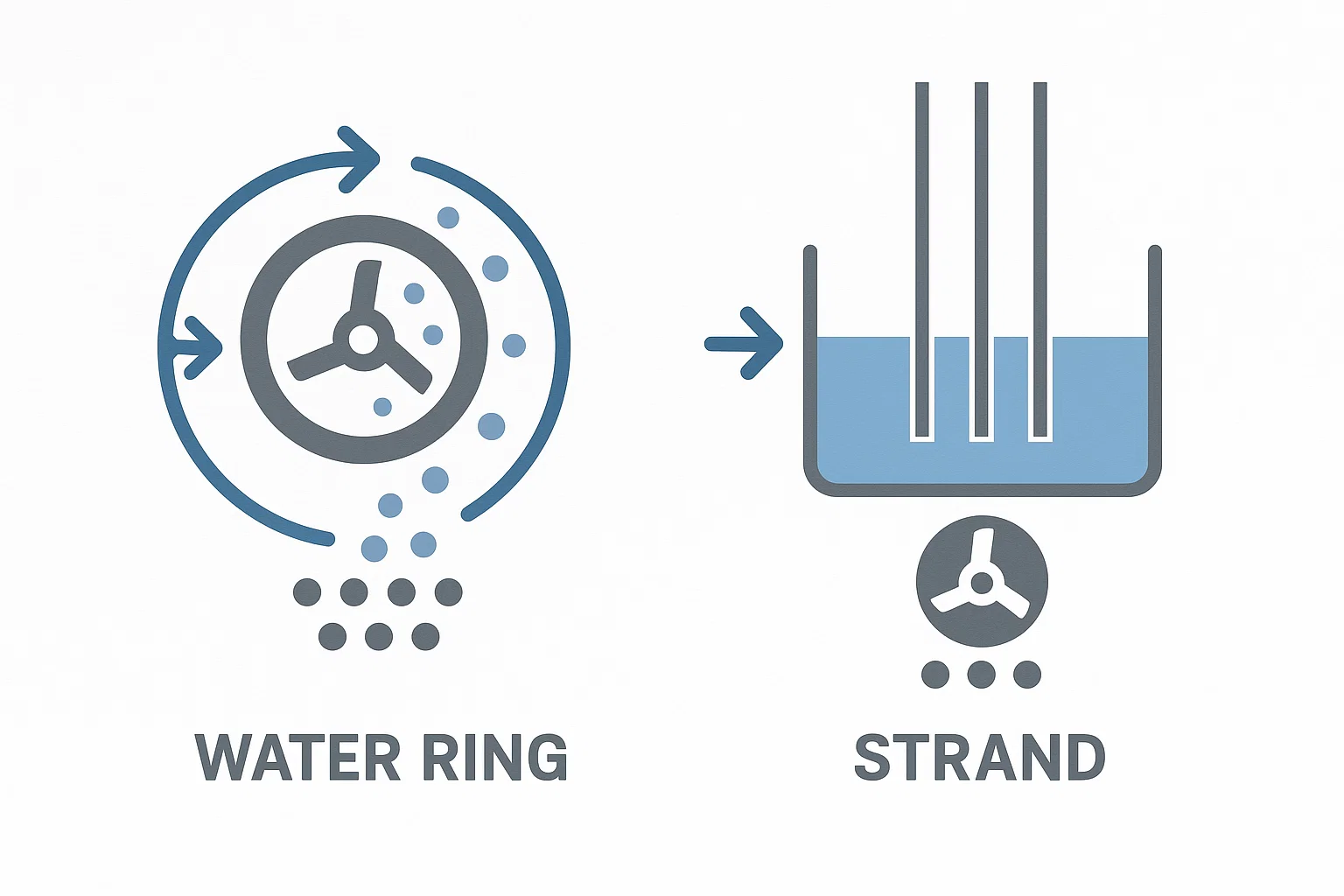Introduction
Choosing the right pelletising system for your PET production line is a crucial decision that can significantly impact your operational efficiency, product quality, and long-term costs. Among the most widely used methods are water ring pelletising and water-cooled strand pelletising. Each system has its advantages and is suited to different production goals and facility constraints.
At Energycle Machine, we specialise in helping manufacturers across the USA and Europe optimise their recycling and polymer processing lines. If you’re exploring systems designed for PET flakes, visit our PET Plastic Flake Single Screw Pelletizer page to learn more about high-efficiency single screw solutions.
This in-depth guide will walk you through a balanced comparison of both pelletising technologies, helping you determine the best fit for your specific needs.
Understanding the Basics of PET Pelletising
PET (polyethylene terephthalate) pelletising is a downstream process in the plastic recycling or virgin polymer production line where molten PET is converted into solid pellets. These pellets are easier to handle, transport, and reuse in manufacturing processes.
The two dominant systems are:
- Water Ring Pelletising: Molten PET is extruded through a die and cut immediately into pellets by rotating blades. The pellets are then cooled in a circulating water ring.
- Water-Cooled Strand Pelletising: Molten PET is extruded as continuous strands, cooled in a water bath, and then cut into pellets.
For PET bottle flakes, Energycle Machine also offers specialised pelletising systems engineered for stable output and consistent pellet quality.
Footprint and Space Requirements
Water Ring Pelletising
Water ring systems are compact and highly integrated. They occupy less floor space, making them ideal for facilities where space is a premium. All major components, including the cutter, water ring, and dryer, are typically assembled as one unit.
Water-Cooled Strand Pelletising
Strand systems require longer floor space due to the cooling water troughs and strand layout. This setup can pose limitations for smaller factories or retrofit installations. However, it may offer more flexibility in handling different material viscosities.
Energycle Machine recommends assessing your plant layout to understand which system fits best into your operational footprint.
Automation and User-Friendliness
Water Ring Pelletising
Water ring systems are generally more automated and require less operator intervention. Blade pressure is often self-adjusting, and pellet drying is integrated, reducing the need for manual handling.
Water-Cooled Strand Pelletising
Strand pelletising systems are more labour-intensive. Operators must ensure proper strand alignment and consistent water flow. Start-up and shutdown require more attention and skill.
For manufacturers aiming to reduce labour costs and improve consistency, Energycle Machine suggests considering water ring pelletising for its automation benefits.
Pellet Shape and Quality
Water Ring Pelletising
Produces rounded, uniform pellets with a glossy finish. These are especially beneficial for high-end applications where pellet aesthetics and flowability matter.
Water-Cooled Strand Pelletising
Pellets are typically cylindrical with slightly irregular ends. While still functional for most downstream uses, they may not meet premium aesthetic or processing standards.
If pellet uniformity and appearance are critical to your application, Energycle Machine recommends water ring systems.
Summary Comparison Table
| Feature | Water Ring Pelletising | Water-Cooled Strand Pelletising |
|---|---|---|
| Footprint | Compact | Larger space needed |
| Automation | High | Medium to low |
| Pellet Shape | Round, uniform | Cylindrical, variable |
| Maintenance | Moderate | Lower wear risk |
| Initial Cost | Higher | Lower |
| Operating Cost | Lower long-term | Higher labour cost |
| Throughput | High | Medium |
| Material Flexibility | Medium | High |
FAQs
Q1: Can I retrofit a water ring pelletiser to my existing PET line?
Yes, many of Energycle Machine’s models are designed for retrofitting, but layout and extrusion parameters must be evaluated.
Q2: Which pelletiser is more suitable for recycled PET?
Water ring pelletising is often better for recycled PET due to its higher throughput and superior drying integration.
Q3: Are there hybrid systems available?
Some systems offer modular options that combine features of both pelletising types. Energycle Machine can consult on customised solutions.
Q4: What’s the typical payback period for upgrading to a water ring system?
Depending on your output and labour costs, payback can range from 1 to 3 years.
Make the Right Choice for Your Production Line
Choosing the right pelletising system can shape the future of your PET production line. Let Energycle Machine help you make an informed, future-proof investment.
Visit our PET Plastic Flake Single Screw Pelletizer page or contact us today to discuss your needs.
Request a Tailored Quote


